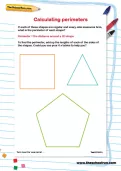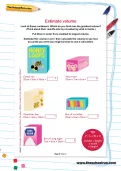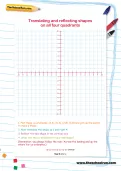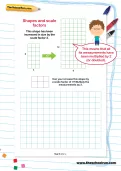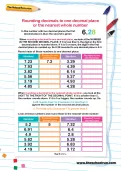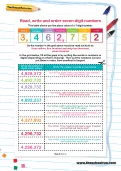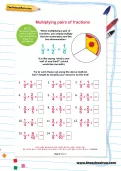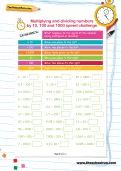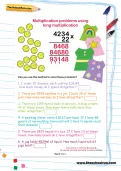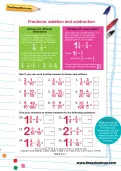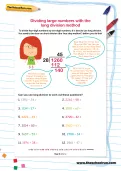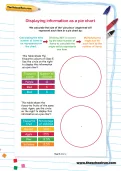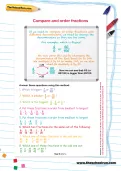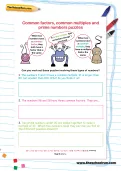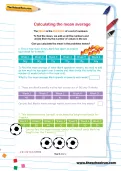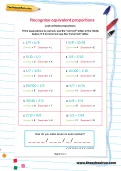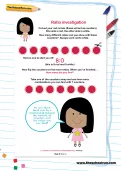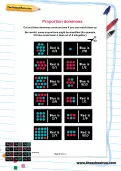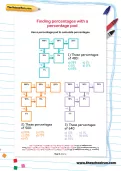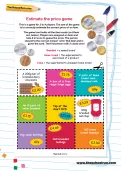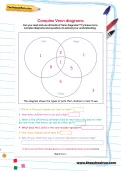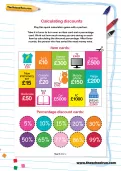Can you translate and reflect these shapes?
or
Register to add to your saved resources
Already a subscriber? to view this content.
Let's try working with scale factors. Can you increase this shape by a scale factor of 3?
or
Register to add to your saved resources
Already a subscriber? to view this content.
Can you round each of these numbers to one decimal place? If you can, try and round the next set to the nearest whole number:
or
Register to add to your saved resources
Already a subscriber? to view this content.
In the grid, fill all the gaps in by writing the words in numbers or digits (depending on what is missing). Then cut the numbers out and put them in order, from smallest to largest.
or
Register to add to your saved resources
Already a subscriber? to view this content.
A Year 6 maths worksheet created by an experienced teacher to help teach your child how to multiply two fractions. Try to work these out using the above method. Don’t forget to simplify your answers as the end!
or
Register to add to your saved resources
Already a subscriber? to view this content.
This Year 6 maths speed challenge was created by a teacher to test your child's multiplication and division skills with numbers by 10, 100 and 1000.
Are you feeling fast?
or
Register to add to your saved resources
Already a subscriber? to view this content.
A Year 6 maths worksheet created by an experienced teacher to help your child practise using the long multiplication method.
or
Register to add to your saved resources
Already a subscriber? to view this content.
Can you add and subtract fractions? See if you can work out the answers to these calculations in this teacher-created maths worksheet...
or
Register to add to your saved resources
To divide four-digit numbers by two-digit numbers, it is best to use long division. You need to be clear on short division (the ‘bus stop method’) before you do this! Can you use long division to work out these questions?
or
Register to add to your saved resources
Already a subscriber? to view this content.
Our downloadable pie chart worksheets are designed to help children understand data on whole numbers, fractions and percentages. This worksheet guides your child through the process of interpreting data represented in pie charts and encourages them to create their own.
or
Register to add to your saved resources
Already a subscriber? to view this content.
If we need to compare or order fractions with different denominators, we need to change the denominators so they are the same. Can you use this method to answer these tricky questions?
or
Register to add to your saved resources
KS2 maths number puzzle worksheet created by a teacher to help children practise common factors, common multiples and prime numbers.
or
Register to add to your saved resources
Already a subscriber? to view this content.
The mean is the average of a set of numbers. To find the mean, we add up all the numbers and divide them by the number of values in the set. Can you calculate the mean in these problems?
or
Register to add to your saved resources
Already a subscriber? to view this content.
If the equivalence is correct, use the “correct” letter in the riddle below; if it is incorrect use the “incorrect” letter.
or
Register to add to your saved resources
Already a subscriber? to view this content.
Cut out your red circles (these will act as counters). One side is red, the other side is white. How many different ratios can you show with these counters? Now flip the counters to find more ratios. When you’ve finished… How many did you find?
or
Register to add to your saved resources
Already a subscriber? to view this content.
Cut out these dominoes cards and see if you can match them up. Be careful, some proportions might be simplified (for example, 2/3 blue could mean 4 blue out of 6 altogether).
or
Register to add to your saved resources
Already a subscriber? to view this content.
Do you know how to use a percentage pod? Use a percentage pod to calculate theses percentages.
or
Register to add to your saved resources
Already a subscriber? to view this content.
This is a game for 2 to 4 players. The aim of the game is to correctly estimate the correct price of an item. The game host holds all the item cards. Players are assigned an item and take it in turns to guess the price. The person closest to the correct answer ‘wins’ that item and is given the card. The first person with 3 cards wins!
or
Register to add to your saved resources
Can you read and use all kinds of Venn diagrams? Try these more complex diagrams and questions to extend your understanding.
or
Register to add to your saved resources
Already a subscriber? to view this content.
Play this quick calculation game with a partner. Take it in turns to turn over an item card and a percentage card. Work out how much money you are saving on each item by calculating the discount percentage. After three rounds, the person who has saved the most money wins.
or
Register to add to your saved resources
Already a subscriber? to view this content.
